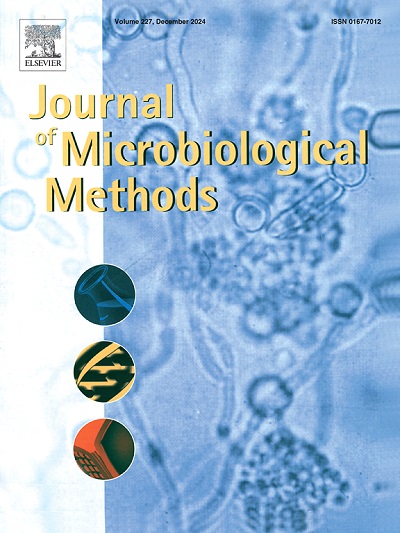用于分类剖析和废水质量评估的全基因组测序方法。
IF 1.9
4区 生物学
Q4 BIOCHEMICAL RESEARCH METHODS
引用次数: 0
摘要
追踪废水中的元基因组丰度无疑是检测新出现的变异并改善社区健康的有力工具。然而,有几个因素限制了基于水的环境基因组监测:采样的可变性、不完全覆盖、基因片段、退化、数据分析和解释。高通量测序和高端超级计算机的成本不断降低,提高了基因组数据在任何特定地区废水样本微生物检测和监测中的使用率和准确性。为了更好地了解微生物动态并确定目标测序通量,以确定可能作为流行病爆发生物指标的分类群,我们采用适当的采样方法从阿拉伯联合酋长国阿布扎比酋长国的不同地点采集了废水样本。建立了一个包含约 27,000 种已知物种的参考数据库,并用于进一步分析。结果显示,每个样本中有 15% 的数据与约 27,000 种已知细菌、病毒、真菌或原生动物中的任何一种相匹配。尽管未分类数据的比例很高(85%),但每个样本中还是检测到了超过 30 个门类超过 800 个属的 2000 多个物种。5 Gb 和 10 Gb 的测序数据都检测到了丰度最高的约 2000 个物种。将目标测序吞吐量提高一倍(即 10 Gb 与 5 Gb 相比),每个样本可额外检测到约 500 个低丰度物种,但这并不影响样本的整体组成,也不会转化为每个样本捕获的更高物种多样性。分类数据超过 0.20 Gb 后,每个样本检测到的物种数量略有增加。总体而言,结果表明,以 3 Gb 的吞吐量进行测序可检测到样本中近 95% 的物种。本文章由计算机程序翻译,如有差异,请以英文原文为准。

Whole genome sequencing approaches for taxonomic profiling and evaluation of wastewater quality
Tracking metagenomic abundance in wastewater is undoubtedly a powerful tool to detect emerging variants and improve community health. However, there are a few factors that limit environmental water-based genomic monitoring: sampling variability, incomplete coverage, genetic fragmentation, degradation, data analysis and interpretation. The decreasing costs of high-throughput sequencing and high-end supercomputers have increased the use and accuracy of genomic data for microbial detection and monitoring in wastewater samples within any given region. To better understand the microbial dynamics and to determine the target sequencing throughput required to establish taxa that may pose as bio-indicators of an epidemiological outbreak, wastewater samples were collected from distinct locations within the Emirate of Abu Dhabi, United Arab Emirates using appropriate sampling methods. A reference database of ∼27,000 known species was developed and used for further analysis. The results showed that 15 % of data in each sample matched any of ∼27,000 known bacterial, viral, fungal, or protozoan species. Despite the high fraction of unclassified data (85 %), more than 2000 species from >800 genera across >30 phyla were detected in each sample. Both 5 Gb and 10 Gb of sequenced data detected the top ∼2000 species with highest abundance. Doubling the target sequencing throughput (i.e., 10 Gb vs 5 Gb) detected ∼500 additional low-abundance species per sample however it did not affect the overall sample composition or translate into higher per-sample species diversity captured. There was a marginal increase in the number of species detected in each sample beyond 0.20 Gb of classified data. Overall, the results indicate that sequencing to a 3 Gb throughput detects nearly 95 % of all species in the samples.
求助全文
通过发布文献求助,成功后即可免费获取论文全文。
去求助
来源期刊

Journal of microbiological methods
生物-生化研究方法
CiteScore
4.30
自引率
4.50%
发文量
151
审稿时长
29 days
期刊介绍:
The Journal of Microbiological Methods publishes scholarly and original articles, notes and review articles. These articles must include novel and/or state-of-the-art methods, or significant improvements to existing methods. Novel and innovative applications of current methods that are validated and useful will also be published. JMM strives for scholarship, innovation and excellence. This demands scientific rigour, the best available methods and technologies, correctly replicated experiments/tests, the inclusion of proper controls, calibrations, and the correct statistical analysis. The presentation of the data must support the interpretation of the method/approach.
All aspects of microbiology are covered, except virology. These include agricultural microbiology, applied and environmental microbiology, bioassays, bioinformatics, biotechnology, biochemical microbiology, clinical microbiology, diagnostics, food monitoring and quality control microbiology, microbial genetics and genomics, geomicrobiology, microbiome methods regardless of habitat, high through-put sequencing methods and analysis, microbial pathogenesis and host responses, metabolomics, metagenomics, metaproteomics, microbial ecology and diversity, microbial physiology, microbial ultra-structure, microscopic and imaging methods, molecular microbiology, mycology, novel mathematical microbiology and modelling, parasitology, plant-microbe interactions, protein markers/profiles, proteomics, pyrosequencing, public health microbiology, radioisotopes applied to microbiology, robotics applied to microbiological methods,rumen microbiology, microbiological methods for space missions and extreme environments, sampling methods and samplers, soil and sediment microbiology, transcriptomics, veterinary microbiology, sero-diagnostics and typing/identification.
 求助内容:
求助内容: 应助结果提醒方式:
应助结果提醒方式:


